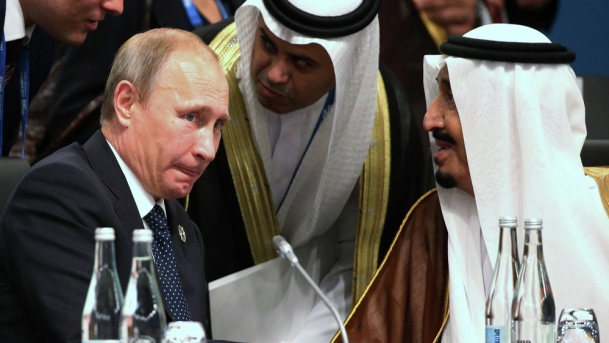
The international conference “Shaping a New Balance of Power in the Middle East: Regional Actors, Global Powers, and Middle East Strategy”, co-hosted by Aljazeera Centre for Studies (AJCS) and John Hopkins University (JHU) in Washington earlier this summer, has triggered wider debate about the nature and the promise of an emerging balance of power in the region. New questions are raised about how a new balance can be different from the traditional U.S.-Soviet politics of bipolarity and rival proxies, the impact of new players, the power of militant groups and other non-state actors, and whether any emerging balance of power can be sustainable in the future. For instance, the Gulf and the Middle East are suffering a paroxysm of conflict involving virtually all the regional states as well as the UNITED STATES and Russia and many different non-state actors. What dynamics are driving this chaos? What can be done to contain or reverse the damage? How might a new balance of power emerge?
As part of a special series “Shaping a New Balance of Power in the Middle East”, AJCS welcomes the insights of Dr. Helle Malmvig, Senior Researcher and Academic Coordinator at the Danish Institute for International Studies (DIIS) in Copenhagen. She contextualizes how most Middle Eastern states have become less dependent on the United States. Accordingly, she examines how “Russia willingness to fill the power vacuum in Syria, in addition to China flexing its economic muscles across the region, have created a new reality.” Dr. Malmvig also probes into the division of the Middle East across the lines of ideational conflicts and proxy-wars similarly divide the region, including the Saudi (Sunni)-Iran (Shia) rift and the salient. She argues the lines of conflict are “different, less bi-polar and more cross-cutting than 50-60 years ago.”
It is 1993, and world leaders are summoned to the South Lawn of the White House. Under President Clinton’s watchful eyes, Arafat and Rabin sign the Oslo Accords, as Clinton motions the two reluctant leaders to shake hands and nods them through a longwinded ceremony. Edward Said acutely observed at the time that Clinton acted as a ‘20th century Roman emperor shepherding two vasal kings through rituals of reconciliation and obeisance’. (1) Fast forward 25 years: in Saudi Arabia, the newly elected President Trump arrives at the ‘Historical Centre’ in Riyadh. Hundreds of men from the Saudi Royal court are on display, holding up their large swords and dancing to traditional music. President Trump has difficulties passing and moving through the crowds and endless halls of the palace compound. At one point, the US President awkwardly attempts to dance along the men with swords, he then smiles warily to the cameras, hoping to land a multi-billion dollars arms deal with the Saudi King.
These two pictures are indicative of a wider change in how the Middle East and global powers interact. As America’s power is declining and multiple powers have taken the stage, Middle Eastern states have, this article will show 1) more room of manoeuvre in foreign policies, 2) can draw powers in and shape their security perceptions, 3) show signs of more independent security dynamics compared to the Post-Cold war era. In short, the Middle East plays less to the tunes of global powers.
Before: The Cold War and Post-Cold War Eras
How was it before? At the height of the Cold War, Carl Brown famously called the Middle East “the most penetrated region in the world.”(2) He meant that the Middle East, with its rich natural resources and acute strategic location, was prey to exceptionally intense foreign intervention and meddling. Outside powers have historically sought to prevent Middle Eastern states from pursuing too independent foreign policies and to keep the region from organizing in autonomous ways, thereby hindering the rise of strong revisionist regional powers and norms.(3)
The United States and the United Kingdom are infamous for their masterminding of the military coup to overthrow the democratically elected Mossadeq in Iran. France and the United Kingdom colluded with Israel to regain the Suez from Nasser, just as the Soviet Union sought to spread communist ideas, infiltrated the PLO and Kurdish movements and at one time kept over 20.000 soldiers in Egypt.(4)Through arms transfers, military bases and billions in direct aid, Europe, the United States and USSR have been steering Middle Eastern states their way, and, at various points, sub-ordinated or exacerbated regional security dynamics to their external agendas.
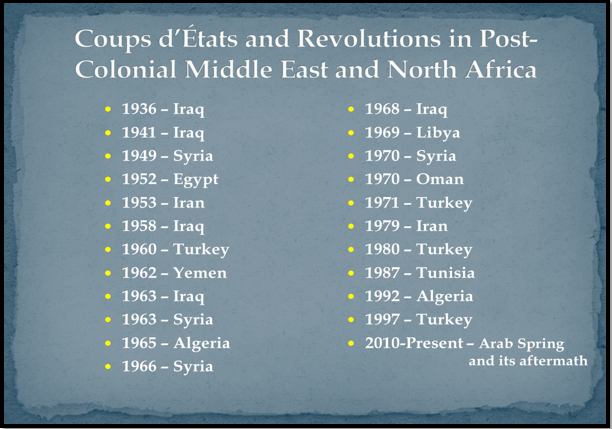 |
| [Foreign Policy Research Institute] |
Yet the Cold War superpower rivalry also gave some wiggle room for Middle East governments. They were never just client states subject to external patrons’ whips and wishes.(5) Middle Eastern states were able gain concessions and leverage by playing off the two superpowers against each other, drawing powers into local conflicts, sometimes against these powers’ immediate interest, threatening to change alliance, and in some cases even doing so. Egypt’s Sadat most famously kicked out the Soviet soldiers of Egypt and shifted from the USSR to the United States, Saudi Arabia used its oil-weapon against the West, and Israel has never been very subservient to US demands. And whereas Europe was ‘overlayed’ by Cold War dynamics, the Middle East kept its own distinct Arab interconnectedness and indigenous security dynamics, where lines of amity and enmity would cut across, or overrule, the two superpowers’ rivalry and security concerns.(6) For instance in the eyes of many Arab states, the real geopolitical threat was not the Soviet Union, but Israel; (7) just as Arabism, anti-imperialism, and solidarity with Palestinians were regional norms that Arab governments and societies widely shared.(8)
By the end of the Cold War, this regional ‘wriggle-room’ narrowed considerably. With the collapse of the Soviet Union, the US was now the only game in town. The Gulf War in 1991 and the Madrid Peace Process ushered in a new Pax Americana, where even former revisionist actors such as Syria and the PLO appeared to subdue to US demands.(9) Syria engaged in cautious peace talks with Israel, PLO signed the Oslo Accords and Jordan made a bilateral peace with Tel Aviv, just as the GCC states came to increasingly depend on direct US military presence for their security.(10) In 2003, the Bush Administration invaded Iraq and overthrew Saddam Hussein. The US boldly declared its intent to spread democracy and liberal values to the whole region starting with Iraq. From its position of near unquestioned unipolarity, the US ventured to shape the region it its image. (11)
Today, the American unipolar moment is long gone. The Iraq invasion and its catastrophic aftermath, US retreat and Russia willingness to fill the power vacuum in Syria, in addition to China flexing its economic muscles across the region, have created a new reality, where the US is only one among many global powers.
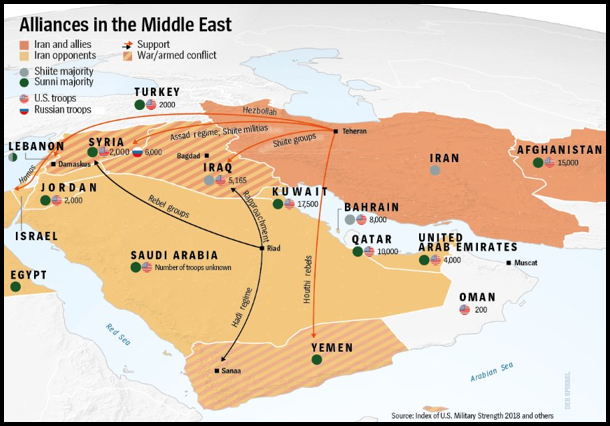 |
| [Index of US Military Strength 2018] |
Playing to its Own Tunes
1) Independent Foreign Policies and Room of Maneuver
Turkey is a telling example of how Middle East governments can pursue foreign policies independent of, or in outright contradiction with, the wills of global powers. Despite being a NATO member and traditionally a close ally of the West, Ankara has managed to follow its own security agenda on the most divisive regional issues, such as the Syrian war, relations with Iran, and the Saudi-led Qatar blockade. On the Syrian file, Turkey, a staunch supporter of the Syrian opposition, has worked for a no-fly zone, prevented US supported Kurdish groups YPG/YPJ from obtaining a contiguous territory, and only very late and reluctantly participated in the fight against the Islamic State. (12) This has resulted in multiple open conflicts, threats of military confrontations with the US in Manbij, and the downing of a Russian jet in November 2015. A year after, Turkey launched its first ground operation (Euphrates Shield) in Northern Syria to remove so-called terrorist groups – including the YPG forces supported by the US. Later the Afrin offensive followed to ‘root out the Kurdish militias” according to Erdogan. (13) US watched with so-called “concern”, but little was done.
Presently, although both US and Russia have close ties with the Syrian Kurds, the two powers appear to have quietly accommodated Ankara’s main security concerns, including accepting Turkish military presence in both the northern border regions and Idlib.(14) In the diplomatic arena, Turkey has similarly gained from its dual relationship with US and Russia. Though Turkey is part of the Western dominated Friends of Syria Group, Ankara is at the same playing a lead role in Russia’s competing diplomatic track (the Astana and Sochi talks) and cooperates with Russia on de-escalations deals and lately on the de-militarized buffer zones in Idlib. By militarily intervening, balancing, and sometimes going up against, the two global powers, Turkey has likely obtained a permanent seat at any future negotiation table over Syria and the ability to decide over the fate of the crucial northern regions.
Egypt, Saudi Arabia and some of the smaller Gulf States have similarly witnessed a widening room of maneuver, even on hard-core security and military matters. Saudi-Arabia has been given free reign in Yemen, where the Kingdom is carrying out a brutal military campaign fighting the Houthis and seeking to put former president Mansour Hadi back in power. In 2014, Egypt and UAE twice launched secret airstrikes in Libya against Muslim Brotherhood aligned forces around Tripoli without informing or seeking approval with the US in advance. This would have been unthinkable only a few years back.(15) And when the Lebanese Prime Minister Hariri suddenly resigned and was put under house arrest in Riyadh in 2017, the US Administration again appeared surprisingly in the dark.(16)
Across the region, US allies are less dependent on Washington, as they can seek various forms of rapprochement with Russia, deepening economic ties with China and buying Russian arms. (17) US is undoubtedly still the most powerful external actor, but Egypt, Saudi, Turkey and even Israel are able to play external powers off against each other, thereby obtaining concessions and leverage. Several US weapon systems were for instance put on hold to Egypt, but later released after Sisi held meetings with Putin and Gulf allies and Israel put pressure on the United States. (18) Meanwhile, non-US allies such as Iran and Syria can circumvent US sanction regimes and trade restrictions through China and Russia, and at times through the EU, who are developing a nifty bank mechanism to facilitate continued trade with Iran (19), despite the Trump Administration’s withdrawal from the JCPOA.
2) Tail Wag the Dog-dynamics: Drawing Powers in and Internalization of Security Perceptions
At times, Middle Eastern governments have even succeeded in maneuvering global powers to do, what they otherwise might not have done. Often such tail wags the dog dynamics work in rather subtle ways, as global powers internalize or uncritically take over the security perceptions of regional allies.
In June 2017, a Saudi-led alliance launched a fierce blockade against Qatar, accusing it of supporting extremism and having relations with Iran. The perception of Qatar as a harbor of terrorism was seemingly shared by President Trump himself. Two weeks prior to the crisis Trump and his family visited Riyadh, as the very first trip overseas. In Riyadh Trump secured a multi-billion arms deal and attended a much-to-do-about-nothing counter-terrorism summit. Afterwards the US President tweeted: “There can no longer be funding of radical ideology. Leaders pointed to Qatar-look!”(20) Trump had turned Saudi security perceptions into his own. The President had, in the words of former US envoy Martin Indyk: “Followed the Saudi script”, apparently unaware that Qatar hosts the Udeid air base, built by Qatar, and used for sorties against Islamic State in Syria and Iraq. (21) Inside the Trump Administration Secretary of State Rex Tillerson set out to correct the course, engaged in intense regional shuttle diplomacy, and quickly signed a memorandum of understanding with Qatar. However, Jared Kushner’s close relationships with the Saudi Crown Prince Muhammed Bin Salman and UAE Crown Prince Muhammed bin Zayed continued to weigh heavily on Trump, while Tillerson eventually was dismissed.(22)The two crown princes allegedly boast of holding Kushner “in the pocket,”(23) and today the Gulf crisis remains unresolved.
The increasing US preoccupation with Iran also has its own tail wag the dog dynamics, as the Trump Administration has taken over Saudi and Israeli security perceptions on Iran. The “adults in the room” prevented Trump from tearing up the Iran nuclear deal for a while, but Trump ended up withdrawing. Netanyahu himself taking credit for Trump leaving the deal.(24) No doubt National Security advisor Bolton and Secretary of State Pompeo have pushed Trump further down this path, but comparing statements from Washington, Riyadh or Tel Aviv on Iran, there is little difference in language or tone.(25) Echoing regional allies, the Trump Administration views Iran as the biggest threat in the region, the largest sponsor of terrorism, and accuses Tehran of seeking to dominate the whole Middle East. At the 2018 United Nations General Assembly (UNGA) meeting, Iran was one of the main topics in Trump’s speech, in which he promised new draconian sanctions and penalties against US’s closest allies, if the Europeans did not cut commercial ties with Iran. (26) Similarly, the Iranian threat appear to have overturned Trump’s impulse to withdraw from war theaters across the Middle East. Despite the fact that Trump numerous times have announced that he wanted to pull out of Syria – including in closed discussions inside the White House(27)- the US is now staying on. Not in order to push the Assad regime to real transition nor to protect the Kurds- but to contain Iran, as Israel and Saudi long have worked for.(28)
 |
| [MEA] |
The United States is hardly the only global power subject to regional states’ abilities to influence security perceptions and lure external powers in to local conflicts. It was allegedly the Iranian general Qasem Soleimani, who persuaded Russia to come to the rescue in Syria in 2015, when Assad and his allies were hard pressed on the battlefield.(29) Russia has gained a huge amount of international and regional leverage because of its military intervention. But, Russia now owns a difficult stabilization and post-conflict situation – reminiscent of US endeavors in Iraq and Afghanistan - and an estimated 400-billion-dollar reconstruction bill that it is eager to share with Europe.(30) Twice, and perhaps out of wishful thinking, Moscow has proclaimed its military operation was over, and troops would be sent home soon.(31)
Moreover, as in the case of the US, Russia’s allies in Syria do not always do, what Russia would like them to. Moscow has for instance strived to enroll the so-called auxiliary forces supported by Hezbollah and Iran into the regular Syrian army, but unsuccessfully. Similarly, Moscow initially persuaded Iran and Hezbollah forces to move further away from Syria’s south-west border to Israel, but only for a while. As the Syrian war draws to a close, Russian tensions with Iran and the many affiliated militias are likely to come to the fore.
3) Autonomous Regional Dynamics
The Middle East has its own autonomous security dynamics that are relatively independent of external forces and powers. The region’s fault lines are dominated – not by global rivalries – but by multiple indigenous contestations. These conflicts are sometimes referred to as a “New Arab Cold War” reminiscent of Arab politics in the 1950s and 60s, where revolutionary republics were pitted against more conservative monarchies. At the time, the two sides battled over regime type, ideology, and the very borders of Arab states, and this led to extensive interventions, as the republics and monarchies waged proxy wars in internal conflicts in e.g. Yemen, Lebanon, and Jordan.(32)
Today, ideational conflicts and proxy-wars similarly divide the region. This applies to the Saudi-Iran rivalry, the gab between state and societies, sectarian and ethnic identity politics, the Arab-Israeli conflict and the role of political Islam. But, the lines of conflict are different, less bi-polar and more cross-cutting than 50-60 years ago. For instance, Turkey, Qatar and Oman try to take a middle-position in the rivalry between Saudi Arabia and Iran. Syria, Hezbollah and Iran are leading what is sometimes called a revisionist, or Shia, alliance against an opposing status-quo Sunni alliance, yet the former also includes Hamas and the rather secular regime of Assad. The Saudi Kingdom and Egypt’s Sisi share concerns over the Muslim Brotherhood and other opposition movements unleashed by the Arab uprisings, but they disagree over the nature of the Assad government and the Syrian rebellion. The Iraqi government continues to entertain close relations with both the US and Iran, both of whom have fought the Islamic State group in Iraq. Arab relations with Israel remain strained, not least because of the plight of the Palestinians. But, behind the scenes, Israel and several Arab states increasingly work together on Iran. In short, regional amity-enmity relations are multiple and contradictory, but they operate rather independently from the international level.
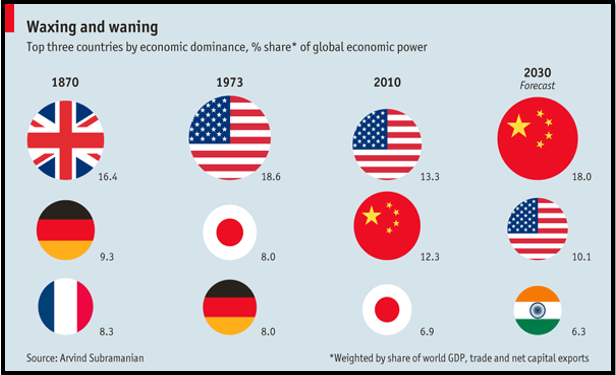 |
| [Arvind Subramanian] |
The region, moreover, is witnessing an authoritarian resurgence and a renewed preoccupation with domestic terrorism and internal dissent, as incumbent rulers primarily think in terms of balancing threats to regime survival, rather than threats to the sovereign state as a whole. The Arab uprisings have given way to civil wars and state fragmentation, opening the gateways to foreign meddling and proxy-dynamics in Libya, Iraq, Syria, Yemen, and as always in Lebanon. Yet, regional actors often play a leading role in these battles e.g. Iran in Iraq and Syria, Saudi-Arabia in Yemen and Lebanon, and Turkey in Syria, just as regional non-state actors shape the many proxy conflicts, by delivering manpower to the fighting on the ground.(33)
Conclusion: Several Melodies Playing
The Middle East remains one of the most militarized and penetrated regions in the world, marked by outside interventions and foreign meddling. Global powers continue having a lot of clout, through transfers of billion-dollar aid, loans, arms export and security guarantees. But, it not a one sided patron-client relationship. Regional middle powers are able to pursue their own security agendas, lure foreign powers in, and play them to their own advantage, just as outside powers’ attempts to impose grand security designs, from the Baghdad Pact to the recent US ploys to create a so-called “Arab NATO”, have immense difficulties succeeding.
What are the security implications of this? While the Middle East may have gained more autonomy, it is also clear that the highly securitized multi-polar order and the ever-shifting coalitions across conflicts and issue areas, is causing intense uncertainty. Misunderstandings are more common and mediation and de-escalation all the more difficult. Moreover, the absence of regional ‘conductors’, in the form of hegemonic regional powers or effective regional organization, disables vital negotiations and conflict resolution. Paradoxically this is of course in part the sad result of previous decades of global penetration and imperial designs. Today, the Middle East still needs to hum to the tunes of global powers, but there are several melodies to play, and no single conductor.
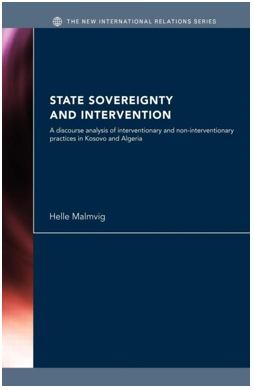 |
|
[STATE SOVEREGNTY AND INTERVENTION Book BY Helle Malving] |
(1) Said, Edward ‘The Morning After’ London Review of Books, 21 October, 1993 p.3
(2) International Politics in the Middle East, Old rules, Dangerous Games, Princeton University Press, Brown, L. Carl 1984
(3) Ibid, see also Ehteshami, Anoushiravan and Hinnebusch, Raymond A Syria and Iran Middle Powers in a Penetrated Regional System , Routledge 1997
(4) See e.g. Halliday, Fred ‘Gorbachev and the Arab Syndrome’ Soviet Policy in the Middle East’, World Policy Journal, Vol 4, no 3, Summer, 1987, pp 415-442
(5) El-Doufani, M.Mohammed, ‘Regional Revisionist States under Unipolarity’ Third World Qaterley, Vol 13, No 2, 1992, pp 255-265 , Karsh Efraim ‘Cold War, Post Cold War: Does it make a difference for the Middle East? Review of International Studies Vol 23, no 3, 1997, pp 271-291
(6) Buzan, Barry and Wæver, Ole ‘Regions and Powers’ Cambridge University Press, Cambridge, 2003.
(7) Hudson, Michael S, ‘To Play the Hegemon: Fifty Years of US Policy towards the Middle East’, The Middle East Journal, Vol 50, no 3, Summer, 1996, p. 330
(8) Barnett, Michael ”Dialogues in Arab Politics: Negotiations over Regional Order’ Columbia University Press, 1998
(9) Ehteshami, Anoushiravan and Hinnebusch, Raymond A op.cit
(10) Hudson ibid, pp. 330-340.
(11) Malmvig, Helle ‘Free Us from Power’ Governmentality, counter-conduct and the Simulation of Reform ‘International Political Sociology, Vol 8, issue 3, 1, 2014
(12) al-Istrabadi, Feisal, ‘Regional Constraints on the US Confrontation of ISIS’ in The Future of ISIS, Eds al-Istrabadi and Ganguly, Sumit, Brookings Institution Press, 2018, p. 184-186
(13) Turkey plans Syrian Safe-zone as shelling of Kurdish area resumes, The Guardian January 22, 2018
(15) Arab Allies Fail in Libya New York Times, Kirkpatrick & Schmitt, 25 august 2014..
(16) ‘Rex Tillerson warns Iran and Saudi: Don’t use Lebanon for Proxy Conflicts, The Telegraph, 10 November 2017
(17) See also Katz, Al Jazeera Studies Center 2018
(18) Trump blinks, and Egypt’s Sisi Wins, Foreign Policy August 10, 2018, Miller Andrew
(19) Iran Deal: EU sets up mechanism to facilitate legitimate trade with Iran despite sanctions, European External Action Service, 25 September, 2018.
(20) GCC crisis: What’s behind Trump’s volte-face on Qatar, The New Arab 19 January 2018.
(22) Woodward, Bob ‘Fear: Trump in the White House’ Simon and Shuster, New York
(23) ‘Saudi Crown Prince boasted that Jared Kushner was in his pocket’, The Intercept , 21 March, 2018
(24) Netanyahu Takes Credit for Trump Leaving Iran Deal”, Jerusalem Post, July 17, 2018.
(25) See e.g. ”Pompeo says: Iran biggest sponsor of terrorism in the world” The National April 29, 2018
(26) Trump’s speech at the UN: Scorn for Iran, Praise for Kim, New York Times 25 September
(28) See e.g. “Saudi Prince says US troops should stay on in Syria”, The Times of Israel April 2018, Donald Trump wants out of Syria, Israel think that’s a problem, Haaratz April 5
(29) How Iranian General Plotted out Syrian assault in Moscow , Reuters 5 October
(30) Cost of Syria war almost 400 billion, UN estimates The New Arab, 9 August 2018
(31) Syria War: Putin’s Russian mission accomplished BBC December 13, 2017.
(32) Curtis Ryan, Morten Valbjørn & Andre Bank, Lynch, Marc
(33) In Syria alone more than 20 foreign actors have militarily intervened, but most of these are regional actors “A mind-boggling stew of nations are fighting in Syria’s civil war” 16 February 2016, USA Today
